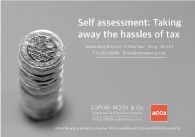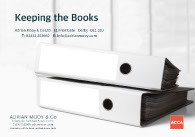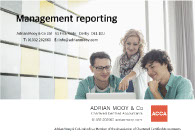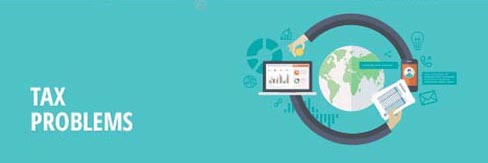Helping you grow your business
Helping you keep more of your income
We understand your needs
Adrian Mooy & Co - Accountants Derby
Welcome to Adrian Mooy & Co Ltd
Call us on 01332 202660
Receive our
Newsletter







... a digital firm using the best tech to help our clients
KASHFLOW
+
SNAP
IRIS
OPENSPACE
SAGE
New clients - easy three step process
MAKING
TAX
DIGITAL
XERO
+
DEXT
CHASER
FUTRLI
FLUIDLY

GO
CARDLESS
like yours grow and be more profitable.
a friendly service covering audit, tax, accounts, self assessment,
We offer a personal service and welcome new clients.
We are a firm of Chartered Certified Accountants
and tax advisors in Derby helping businesses
From start-up to exit & everything in-between.
Whether you’re struggling with company formation,
annual accounts and taxation, payroll or VAT you can
count on us at every step of your business’s journey. For
VAT & payroll please contact us.
Contact us
- Visit our office
- Request a callback
- Submit an enquiry
- Call us
- Email us
Building a relationship
- Initial consultation
- Understanding your
personal or business circumstances and requirements
Get a fixed fee
- Written Service Proposal
- Service breakdown
- Fixed fee quote
- Issue an Engagement
Letter
If you are looking for a Derby accountant please contact us.
○ Tax solutions to help you keep more of your income
○ Cloud-based accounting solutions
○ Transparent affordable pricing

We offer cloud-based accounting solutions. Using good technology saves time. With the power of cloud accounting in your hands, you can access accurate real-time data on the go, accept instant payments and even automate repetitive tasks like invoicing. Fast, easy, touch-of-a-button software can make a real difference to the way you run your business.

02/12/2015
Writer Name
Blog Post Title
Read more
Today's blog post
Services
We offer a range of high quality services

Self-employed sole traders
If you are starting your own business, running it as a sole trader is the quickest and easiest way to do it. However, you will have unlimited liability which means you are personally responsible for business debts.
Another important aspect is that you are taxed on all the profits with little opportunity for tax planning. This is why most businesses will incorporate as profits increase.
We can support you through business registration and provide advice on all aspects of tax including:
◦ Accounts for HMRC ◦ Self assessment ◦ VAT returns ◦
◦ Payroll services ◦ Tax planning ◦
Partnerships
Partnerships are similar to sole trades, except that they are used when more than one person owns the business.
Each profit share is determined by the partners and best practice is to record this in a partnership agreement.
With partnerships each partner has joint and several liability for the debts of the partnership, so that if one partner cannot pay their share of any business debts, the debt will fall on the other partners.
Setting up a partnership agreement from the outset is essential.
Limited companies
Corporate tax planning can result in significant improvements in your bottom line. Our services will help to minimise your corporate tax exposure.
Services include:
- Determining the most tax effective structure for your business

Self assessment
Self assessment tax returns are becoming increasingly complex and failing to submit your return on time, or correctly, can result in substantial penalties.
We use the latest tax software to ensure that tax returns are completed efficiently, accurately and on-time.

Self assessment: Taking
away the hassles of tax
We provide a comprehensive personal tax compliance service for individuals that includes:
- Completing your personal tax return
- Calculating your liability for the year and advising you of the due dates for payment
- Dealing with claims to reduce payments on account, which can be beneficial
- Dealing with HM Revenue & Customs investigations and aspect enquiries
Contractors & IR35
Invoicing your contracting work through a limited company is tax efficient. We will advise you on how to structure your contract to minimise IR35 risk. We will ensure you claim all the expenses that you are entitled to and work out if you can save money by joining the VAT Flat Rate Scheme. We will complete your accounts and tax returns and provide you with clarity over your tax payments.
Included in the service • IRIS KashFlow + Snap • Annual accounts • Corporate tax return • Personal tax return • Payroll • Dividend administration • VAT returns • Contract reviews • Dealing with HMRC
VAT, payroll, CIS & bookkeeping
VAT • is one of the most complex tax regimes imposed on business. We provide a cost effective service including assistance with registration & completing your returns.
Payroll • Administering your payroll can be time consuming. We provide a comprehensive payroll service.

Your Payroll Solution
Construction Industry Scheme • CIS returns & payments
Book-keeping • Maintenance of accounting records
Provision of management accounts
For more about these services please contact us.

Keeping the Books
Audit & assurance
Assurance
If your business does not require a statutory audit then our Assurance Service will provide reassurance that your accounts stand up to close scrutiny from your bank or other finance providers.
Work is tailored to your specific requirements and the level of confidence that you are looking to achieve and will provide credibility to your accounts by the issuing of an assurance review report.
Audit
We strive to provide an auditing service that adds more value than merely the statutory compliance requirement of an audit.
We tailor the audit to meet your circumstances and needs. Using the latest techniques and software we deliver a cost-effective audit that provides real value.
Business start-up advice
Before starting out you may need help with business planning, cash flow and profit & loss forecasts.
You may also want help identifying the best structure for your business. From sole trades and partnerships to limited companies and limited liability partnerships, we have the experience to advise on the best solution for you both operationally and from a tax point of view.
We also advise on accounting software selection, profit improvement, profit extraction & tax saving.
If you wish to know more about our Business Start-up service please contact us on 01332 202660.
Landlords & property
Accountancy and taxation of property is a specialist area. We have the expertise and experience to work effectively with private landlords and property investors. We deal with self-assessment tax, accounts preparation & tax advice for all aspects of property portfolios.
Whether you are a first time buy to let landlord or a long established developer we will discuss and understand your situation in order to advise and recommend the most appropriate medium through which to carry out your property investments. We will guide you through the accounting and tax issues and help you to plan effectively.
- Tax returns
- Property accounts
- Company accounts
- CGT and income tax planning
- VAT advice

Accounts services
Annual Accounts Preparation
We take the time to explain your accounts to you so that you understand what is going on in your business.
Management Accounts
Up to date, relevant and quickly produced management information for better control.

As part of our accounts service we prepare your annual accounts and complete yearly personal and business tax returns.
As your year-end approaches we will agree a timetable with you for completion of the accounts that minimises disruption to your business and leaves no late surprises when it comes to your tax liabilities.
We can also prepare management accounts to help you run your business and make effective business decisions. Management accounts are also very useful when approaching lending institutions when no year end accounts are available. We offer:
- Monthly or quarterly management accounts
- Budgeting and forecasting
- Management reports identifying key variances and recommendations
For a meeting to discuss your requirements please call us on 01332 202660.

Accounts
Tax services
Our objective is to ensure you pay the minimum tax required by law.
Corporation tax
We understand the issues facing owner-managed businesses.
Self Assessment
We provide advice on personal tax & planning opportunities.

Everyone who is subject to tax needs professional advice and support if they are to optimise their tax position and ensure they meet the compliance requirements.
Corporation tax services
Under Corporation Tax Self Assessment the legal responsibility for correctly calculating the corporation tax liability falls on business owners. We will help to minimise corporate tax exposure and relieve the administrative burden of compliance with current tax legislation.
Personal tax services (including sole-traders and partnerships)
We take the headache out of Self Assessment and provide you with practical advice on personal tax and the planning opportunities available to you. Over recent years HMRC have increased the penalties for failing to file a return on time and for errors. We complete tax returns, calculate any tax liability and advise you on exactly when to make payments.
Payroll
Running a small business places many demands on your time. We can help lift the load with our complete payroll service.
Designed to ease your administrative burden, our service removes what is often a time consuming task, leaving you free to concentrate on managing your business.

Meeting your obligations as an employer can be daunting especially with the introduction of Real Time Information (RTI).
Throughout the year, we will calculate your employees' net pay, report the relevant information to HMRC and provide you with payslips for your staff. Late payments or underpayments of employers' deductions can now lead to hefty penalties.
We can also prepare your benefits and expenses forms and advise you of any filing requirements and national insurance due. Benefits and expenses can be a complicated area and knowing what to report can be tricky.
We can file all your in-year and year end returns with HMRC and provide you with P60s to distribute to your employees at the year end.
We also offer a solution to meet your auto-enrolment obligations.
VAT
Guiding you through the complexities of VAT
Businesses dealing with the requirements of VAT legislation will agree that this is often a complex area.
Our VAT services cover all the basics, helping you to meet your obligations. Contact us to see how we can help you.

Determining whether you need to register for VAT, handling the administration of your returns and ensuring you are paying the correct amount of VAT can be both time consuming and complicated.
Our compliance services offer support for all stages of completing your VAT returns, whether you need advice on the treatment of specific transactions or have produced your records and would like verification that they are correct.
We can also advise on the pros and cons of voluntary registration, extracting maximum benefit from the rules on de-registration and the Flat rate VAT scheme.
Our consultancy service guides you through the intricacies of the legislation, pinpointing areas where you may be able to relieve or partly relieve the cost of VAT for your business, for example when purchasing new equipment or undertaking new projects such as property development.
For a meeting to discuss VAT and obtain further advice please call us on 01332 202660.
Tax planning
Corporate tax planning
We can conduct a full tax review of your business and determine the most efficient tax structure for you.
Personal tax planning
We give personal tax advice to a wide variety of individuals, including higher rate tax payers, company directors & sole traders.

We can help with tax planning to ensure that the tax impact of a strategy is considered.
Efficient tax planning can make a significant difference to the amount of tax that ultimately becomes payable. We constantly review developments in taxation and are always on hand to add our expertise to any planned course of action or transaction to achieve maximum tax efficiency.
We can assist with:
- Business structuring and profit extraction
- Capital Gains Tax planning
- Tax efficient restructuring
- Trust tax planning
- Wealth protection, including Inheritance Tax planning & Pensions planning
For a meeting to discuss your requirements please call us on 01332 202660.

Tax
Planning
Web-based accounting
Xero is a web-based accounting system designed with the needs of small business owners in mind.
It can automatically connect to your bank and download your bank statements. From there it’s simple to tell Xero what transactions relate to and once told it remembers and looks out for similar transactions. This saves time and makes keeping your accounts up to date easier.
 Log in from any web browser. As your accountant we can log in and provide help.
Log in from any web browser. As your accountant we can log in and provide help.
Making Tax Digital - VAT

Our Process
Understand your needs
Firstly we listen and gain an understanding of your business and what you are aiming to achieve.
Continuous improvement
We seek your opinions on the service we provide and respond to feedback in order to upgrade and improve what we do.
Build a relationship
Success in business is based around relationships and trust. Our objective is to develop and build strong relationships with our clients, based on two way trust and respect.
Confirm your expectations
Our aim is to help you maximise your business potential and we tailor our service to meet your requirements and agree a timetable for delivering them.
Actively communicate
Communication is important to the success of any commercial venture. It is therefore a vital part of our work with you, sharing the knowledge and ideas that help you to realise your ambitions.
Our Process
Understand your needs
Confirm your expectations
Actively communicate
Build a relationship
Continuous improvement
Straightforward and easy to deal with Adrian Mooy & Co provide an efficient, friendly and professional service - payroll, tax returns, annual accounts and VAT returns are always done on time. Eddie Morris
Call us on 01332 202660
Testimonials
First class! Super accountant! We have been with Adrian Mooy & Co since 1994. They provide a prompt, accurate & reliable service. There is always someone at the end of the phone to help and advise us. They have always delivered and we are more than happy to recommend them. Ian Cannon
Helpsheets
2025 Autumn Budget - Significant points & Personal tax
Significant points
Personal tax allowances and rates on general income frozen for a further three years to April 2031
Also frozen: NICs employer threshold and upper earnings limit, and IHT nil band, to April 2031; Plan 2 Student Loan repayment threshold to April 2030
No immediate changes to reliefs on pension schemes, but salary sacrifices above £2,000 to be subject to National Insurance from April 2029
Increases in income tax rates on dividend income from April 2026, and on rental and savings income from April 2027
Only minor changes to Inheritance Tax rules announced last year
ISA investment limits and rules remain the same, but from April 2027 new £12,000 limit for cash within the £20,000
Corporation tax rates unchanged, but Writing Down Allowances reduced from April 2026; new FYA from 1 January 2026
Council tax surcharge on properties worth over £2 million to apply from April 2028
Personal Income Tax
Tax rates and allowances – 2026/27
In 2023, the previous Chancellor announced that the main personal allowance and the 40% threshold will remain at their 2022/23 levels until the end of 2027/28. In a major tax raising measure, Chancellor Reeves has extended this freeze to the end of 2030/31, in spite of stating explicitly in last year’s Budget that the normal increases in the thresholds would resume in April 2028.
This has been widely criticised as a ‘stealth tax’, in that it increases the amount collected without explicitly increasing rates or reducing allowances. For example, a person with a salary of £50,270 will pay £7,540 in income tax in 2025/26; if their income increases by 10% to £55,297 in any of the years to 2030/31, all of the increase will be taxed at 40%, and they will pay £9,551. The forecasts accompanying the Budget show expected revenue of over £12 billion from this in 2030/31, the largest tax-raising measure in the table.
The income level above which the personal allowance is tapered away also remains £100,000; it will be reduced to zero when income is £125,140, which is also the threshold for paying 45% tax. In the tapering band, the loss of tax-free allowance creates an effective marginal rate of 60%. Once again, annual increases in income will bring more people into these higher rates.
Dividend income - The dividend allowance exempts some dividend income from tax, although that income still counts towards the higher rate thresholds. For 2026/27, the allowance is unchanged at £500. As HMRC does not routinely receive information about dividends received by taxpayers, this low limit is likely to require people to file tax returns to declare even small tax liabilities on dividends.
In 2026/27, the basic and higher rates on dividend income over £500 will rise by 2% to 10.75% and 35.75%; the additional rate will remain 39.35%.
The higher rate also applies to tax payable by close companies (broadly, those under the control of five or fewer shareholders) on ‘loans to participators’ that are not repaid to the company within 9 months of the end of the accounting period. This therefore also increases to 35.75% from 6 April 2026.
Dividends arising in an ISA or a qualifying VCT are not taxed and do not count towards the allowance.
Savings income and property income - The savings allowance remains £1,000 for basic rate taxpayers, £500 for 40% taxpayers and nil for 45% taxpayers. People with savings income above these limits may have to declare it in order to pay tax.
The savings rate band remains at £5,000. Non-savings income is treated as the ‘first slice’ of income, using the tax-free allowance and the savings rate band; if any of the £5,000 band is not used by this ‘slice’, any savings income falling within that band is taxed at 0%.
The Chancellor announced an increase in the tax rates applicable to income from property and savings to apply from April 2027. The basic, higher and additional rates on rental and savings income will all rise by 2% in 2027/28 to 22%, 42% and 47%.
From April 2027, there will be new rules about the order in which certain tax reliefs are deducted from income, so that they must be set first against income which is taxable at the lower rates before they can be set against savings, rental and dividend income.
The Budget document points out that 90% of people do not pay tax on savings income; however, for those whose income from these sources exceed their tax-free allowances, it will be necessary to calculate and settle the liability each year.
These tax increases make tax-free Individual Savings Accounts even more attractive, as any income or gains arising within an ISA are tax-free.
Winter fuel payment - Earlier this year, the government relented and restored the Winter Fuel Payment to pensioners. However, it will be clawed back through the tax system from anyone with income of over £35,000. This can be avoided by disclaiming the payment in advance. The threshold of £35,000 will remain fixed for the duration of this Parliament.
2025 Autumn Budget - Employees
Company cars
The basis for taxing company cars and fuel provided for private use is set out in the Table. Annual increases in the rates for use of the car have already been set up to 2029/30 ‘to provide long-term certainty for taxpayers and industry’. The rates are intended to provide a strong incentive to use electric vehicles, while rates for hybrids will be increased to align more closely with the rates for internal combustion engine vehicles.
The figures used to calculate the following benefits all increase for 2026/27 by 3.8% in line with inflation:
l the benefit of free use of business fuel for private journeys;
l the taxable amount for the availability of a van for more than incidental private use;
l the taxable amount for an employee’s private use of fuel in a company van.
Expenses and benefits
From 6 April 2026, employees will no longer be able to claim a tax deduction for expenses of working from home, if these are not reimbursed by their employer. Employers will still be able to reimburse such costs where they are eligible without deducting income tax or NICs.
Also from 6 April 2026, the income tax and NICs exemption for employer-provided benefits will be extended to cover reimbursements for eye tests, home working equipment, and flu vaccinations.
Enterprise Management Incentive (EMI) Scheme
Under this scheme, employees and directors can be granted options over shares in the company for which they work. No Income Tax or NICs arise if options are exercised within ten years of being granted. Other conditions apply.
For eligible companies, the following maximum limits will apply to EMI contracts granted on or after 6 April 2026:
l the total value of company options that can be unexercised at any time will be increased from £3 million to £6 million;
l gross assets will be increased from £30 million to £120 million;
l the number of employees will be increased from 250 to 500 employees.
The maximum value of unexercised options an individual employee can hold remains £250,000.
The limit on the exercise period will be increased from 10 years to 15 years. Existing contracts can be amended without losing the tax advantages the schemes offer.
Image rights payments
From 2027/28, all image rights payments related to an employment will be treated as taxable employment income and subject to income tax, employer NICs and employee NICs. This will affect sports people who set up image rights companies to accumulate payments for the rights and follows a recent case involving the former England football captain Bryan Robson, which HMRC lost.
2025 Autumn Budget - NIC's, Savings and Pensions
Thresholds and rates
There has been a great deal of debate about the effect on employment and business of the increases in employer NICs that took effect on 6 April 2025 following the Chancellor’s first Budget in October 2024. In the present Budget, no changes were announced – the £5,000 threshold for secondary contributions will remain fixed until April 2031 (in the 2024 Budget, the Chancellor said this figure would rise with inflation after April 2028). The Upper Earnings Limit for employee contributions is linked to the 40% income tax threshold, and is therefore also fixed to the same date.
The Lower Earnings Limit and Small Profits Threshold will be increased for 2026/27 in line with inflation at 3.8%.
Class 2 NICs
It has been possible to ‘buy in’ to the State pension by paying voluntary Class 2 NICs in certain circumstances. The Budget included measures to restrict the availability of this route to a State pension for people resident outside the UK with effect from 6 April 2026. There will be a wider review of voluntary NICs in the new year
Savings and Pensions
Individual Savings Accounts (ISA)
The investment limits for ISA have not changed since 2017/18: they are £20,000 for a standard adult ISA (within which £4,000 may be in a Lifetime ISA), and £9,000 for a Junior ISA or Child Trust Fund. These will now remain fixed until 5 April 2031.
From 6 April 2027, no more than £12,000 of the £20,000 will be eligible for investment in a cash ISA, apart from ISAs for those aged 65 and over. The Chancellor presented this as an encouragement to invest in stocks and shares, which have performed substantially better than cash deposits over the years since ISAs were introduced.
Pension contributions
Among the rumours circulating in advance of the Budget was the possibility of restrictions on tax-free pension lump sums or the amounts that can be invested with tax relief. In the event, the Chancellor made no immediate changes to the reliefs available.
The maximum amount that can be withdrawn as a tax-free lump sum remains £268,275 unless the person is entitled to ‘protection’ in relation to the original introduction of the Lifetime Allowance or any of the subsequent reductions of the limit.
The only change relating to pension funds was another measure that was widely predicted: a restriction on ‘salary sacrifice’ arrangements. From April 2029, full tax relief on such an arrangement will be restricted to a contribution of £2,000. On amounts in excess of that, employer and employee NICs will be due as if cash salary has been paid (although the contribution will still be free of income tax).
Venture capital schemes
Generous tax reliefs are available for those who invest in Enterprise Investment Scheme (EIS) companies or Venture Capital Trusts (VCTs), which are quoted investment trusts that invest in EIS-type companies. These schemes have a lot of detailed conditions attached to them, some of which are being changed to make the schemes available to larger companies.
The gross assets requirement that a company must not exceed for the EIS and VCT will increase to £30 million (from £15 million) immediately before the issue of the shares or securities, and to £35 million (from £16 million) immediately after the issue.
The annual investment limit that caps how much companies can raise will increase to £10 million (from £5 million) and, for knowledge-intensive companies, to £20 million (from £10 million).
The company’s lifetime investment limit will increase to £24 million (from £12 million) and, for knowledge-intensive companies, to £40 million (from £20 million).
These increases apply only to qualifying companies that are not registered in Northern Ireland trading in goods or the generation, transmission, distribution, supply, wholesale trade or cross-border exchange of electricity. These companies will remain eligible only for the current scheme limits.
The Income Tax relief that can be claimed by an individual investing in a VCT will reduce to 20% from the current rate of 30%.
These changes take effect from 6 April 2026.
2025 Autumn Budget - Business Tax
Business rates
From 1 April 2026, business rates bills in England ‘will be updated to reflect changes in property values since the last revaluation in 2023’. The small business multiplier is being reduced to 43.2p and the standard multiplier to 48p.
The government will also introduce permanently lower multipliers for retail, hospitality and leisure (RHL) properties with rateable values under £500,000, set 5p below the national rates, making the small business RHL multiplier 38.2p and the standard RHL multiplier 43p. This will benefit over 750,000 RHL properties.
A new high-value multiplier will apply to properties above £500,000, such as the big warehouses of online retailers. This higher rate is being set at 2.8p above the national standard multiplier, making the high-value multiplier 50.8p in 2026/27.
Umbrella companies
An umbrella company employs workers on behalf of agencies and the businesses that the workers do the work for (the end client). From 6 April 2026, recruitment agencies and end clients will be jointly and severally liable for any payroll taxes on payments
to workers supplied through umbrella companies, where a non-compliant umbrella company fails to remit them to HMRC on their behalf.
If the labour supply chain has:
- more than one agency, the rules apply to the agency that has the direct contract with the end client to supply the worker;
- no agency, the rules apply to the end client.
Corporation Tax
Rate of tax
The rates of corporation tax have not changed, and last year’s Budget appeared to rule out changes for the life of the Parliament.
Late filing
From 1 April 2026, the penalties for late filing of corporation tax returns will be doubled. They will become £200 for any lateness (£1,000 for the third successive offence); a further £200 (or £1,000) if the return is still not filed after 3 months; and tax-geared penalties of 10% of the amount unpaid if they are still not filed after 6 and again after 12 months.
Capital allowances for plant and machinery
The 2025 Budget introduces several changes to capital allowances that will affect the timing of tax relief for businesses over the next two years.
The 100% First Year Allowance for new zero-emission cars and chargepoints has been extended until 31 March 2027 (5 April 2027 for unincorporated businesses), giving an additional year for businesses to secure full upfront relief on electric vehicles before these assets revert to slower relief through writing-down allowances.
A new 40% First Year Allowance will apply to qualifying main-rate plant and machinery from 1 January 2026, where full expensing or the £1 million Annual Investment Allowance are not available. This relief will be available to all businesses, including unincorporated businesses and those acquiring assets for leasing in the UK. Cars and second-hand assets are excluded.
From April 2026, the main rate writing-down allowance will reduce from 18% to 14%, slowing tax relief where upfront allowances cannot be claimed. The special rate writing-down allowance remains unchanged at 6%.
Full expensing continues unchanged for companies and remains the most beneficial route where available. Businesses with material or recurring capital expenditure should review investment plans ahead of the April 2026 changes to optimise relief.
R&D
The government will pilot a targeted advance assurance service from spring 2026, enabling small and medium-sized enterprises to gain clarity on key aspects of their R&D tax relief claims before submitting them to HMRC.
2025 Autumn Budget - CGT & IHT
Capital Gains Tax
Rates and annual exempt amount
In her first Budget, the Chancellor increased the rates of CGT and reduced a number of reliefs. The current Budget document included the forecast that the annual yield from the tax will more than double from £13.7 billion at the start of this Parliament to £30 billion in 2030/31.
The CGT annual exempt amount remains £3,000 for individuals and estates and £1,500 for most trusts. Individuals will continue to pay 18% on gains that fall within their basic rate income tax band, and 24% on gains above that.
Disposals to Employee Ownership Trusts
A CGT relief has exempted gains on eligible disposals of shares to Employee Ownership Trusts. The government will reduce the CGT relief available from 100%
of the gain to 50%. This will take immediate effect from 26 November 2025. Business Asset Disposal Relief (see below) will not be available on the remaining chargeable 50%.
Incorporation relief
When a sole trader or partnership transfers a business to a company in exchange for shares, any capital gains arising on the disposal of chargeable assets may be deferred by ‘incorporation relief’. Under the existing legislation, this operates automatically where the conditions are satisfied. From 6 April 2026, it will be necessary to make a claim for the relief to apply.
Business Asset Disposal Relief (BADR) and carried interest
As announced last year, the tax rate on gains that qualify for BADR will rise in 2026/27 from 14% to 18%. The relief remains available on qualifying gains with a lifetime limit of £1 million.
Investors’ Relief can give a reduced CGT rate to qualifying investors in qualifying companies for which they do not work. The lifetime limit is also £1 million and the rate of tax will rise in line with BADR.
In 2025/26, the rate of CGT on carried interest was a flat rate of 32% for individuals, estates and trusts. From 2026/27, carried interest will be brought within income tax and subject to its own specific rules.
Cryptoassets
Gains realised on cryptoassets such as Bitcoin are likely to be chargeable to CGT. In order to make sure that chargeable gains are being reported, the government will require UK-based Cryptoasset Service Providers to report on their UK tax resident customers under the Cryptoasset Reporting Framework. Information for first reports to HMRC will be collected from 1 January 2026 and reported to HMRC in 2027.
Inheritance Tax (IHT)
Rates - The IHT nil rate band has been fixed at £325,000 since 6 April 2009. The Chancellor has extended the freeze on this figure until the end of 2030/31. Holding the threshold at the same amount for 22 years will bring far more people into the scope of the tax. The Budget document states that IHT raised £8.3 billion a year at the start of this Parliament; this is expected to rise to £14.5 billion in 2030/31.
The £175,000 ‘residential nil rate band enhancement’ on death transfers (also frozen, together with the £2 million value of estate above which it is tapered) can reduce the impact where it applies. A married couple may be able to leave up to £1 million free of IHT to their direct descendants (£325,000 plus £175,000 from each parent), but the rules are complicated, and the prospect of the nil rate band being fixed for another
5 years increases the importance of proper IHT planning.
Agricultural and business property
The government has confirmed that the well-publicised restrictions on 100% agricultural and business reliefs will come in, as previously announced, from 6 April 2026. 100% relief will be restricted to £1 million of the total of qualifying agricultural and business property, with 50% relief on any higher value.
It was newly announced that the £1 million 100% allowance will be transferable between spouses, if it is not used on the first death, and this figure also will be frozen until April 2031.
Also from 6 April 2026, qualifying shares quoted on the AIM and similar ‘unlisted’ markets will qualify for 50% relief rather than the current 100% relief.
These changes could potentially create significant IHT liabilities for family farming and trading businesses in the future, including where business assets are held in trust. All businesses should consider their IHT position, including reviewing wills and considering whether some lifetime gifts of qualifying property may be worthwhile.
Unused pension funds and death benefits
The government has confirmed that, from 6 April 2027, most unused pension funds and death benefits will come within the deceased’s estate for IHT purposes, whether written into trust or not.
2025 Autumn Budget - VAT & Property Tax
Value Added Tax
Registration threshold
The VAT registration and deregistration thresholds last increased to £90,000 and £88,000 with effect from 1 April 2024. The March 2024 Budget stated that they will be again frozen at these new levels, but it did not say for how long. No changes or dates have been announced.
Private hire vehicles
The VAT treatment of private hire vehicles has been thrown into doubt by several court decisions involving Uber and other operators. The Tour Operators Margin Scheme (TOMS) has been held to allow firms to account for VAT only on the difference between the fare and the amount paid to the driver. While the past tax treatment is still the subject of ongoing litigation, the government will put the position beyond doubt going forward: from 2 January 2026, taxi and private vehicle hire services will not be eligible for the TOMS, except where they are provided as part of a package with certain other travel services. This means that a firm will have to account for VAT on the whole of a customer’s fare, where the firm has a contract with the customer as principal responsible for providing the ride.
Gifts to charity
A new VAT relief will be introduced from 1 April 2026 for business donations of goods to charity which are for distribution to those in need or for use in the delivery of their charitable services. Currently a business making such a gift could be liable for output tax on a deemed disposal of the goods.
E-invoicing
From April 2029, it will be a requirement to issue all VAT invoices in a specified electronic format. The government will work on a ‘roadmap’ towards implementation of this measure and will publish this next year.
Low value imports: customs duty
The government intends to remove the customs duty relief on goods imported into the UK valued at £135 or less, making them subject to customs duty from March 2029 at the latest, and is consulting on implementing a new set of customs arrangements for these goods.
Motability
The Motability scheme enables eligible people to buy vehicles that are adapted to enable them to use them, and provides some VAT reliefs. The Budget will impose, with effect from July 2026, 20% VAT on top-up payments that a user can make to have a more expensive vehicle through the scheme.
Property Taxation
‘Mansion tax’
The High Value Council Tax Surcharge (HVCTS) is a new charge on owners of residential property in England worth £2 million or more (in 2026), which will take effect in April 2028.
Homeowners, rather than occupiers, will be liable to the surcharge and will continue to pay their existing Council Tax alongside the surcharge.
The Valuation Office will conduct a targeted valuation exercise to identify properties above £2 million. Revaluations will be conducted every five years.
Properties above the £2 million threshold will be placed into bands based on their property value. Charges will increase in line with CPI inflation each year from 2029/30 onwards.
The surcharge will be £2,500 for properties between £2 million and £2.5 million and rises to £7,500 for properties above £5 million.
Reclaiming VAT on a car – notoriously difficult to claim

The VAT tax rules are clear - input tax cannot be claimed on the purchase of a new or used car that is made available for any private use. However, input tax can usually be claimed on cars used as a tool of a trade such as by a driving school, taxi firm or private car hire business, even if there is minor private use.
This strict rule was tested in a recent tax case of Maddison and Ben Firth T/A Church Farm v HMRC 2002. This case also underlines the importance of documents when submitting a claim to HMRC.
Mr and Mrs Firth were in business registered for VAT as 'subcontracting glam/camping, weddings and events' - mainly organising weddings and other events. The business claimed input tax on the purchase of two new cars, on the basis that they were used exclusively for business purposes and not available for private use. However, the Tribunal agreed with HMRC that there was insufficient evidence to prove a business-only intention. Importantly they came to this conclusion based on the insurance policy which included insurance for 'Social, Domestic and Pleasure' (SDP). Although Mr Firth explained that it was very difficult to obtain insurance without SDP the option was still available and that was enough to refuse the claim. The Tribunal stated that fact that the insurance policies did not cover the carrying of passengers on a commercial charge basis was an important point and refused the claim. Relevant factors quoted in the case were 'who has access to the car and when; what is the likelihood that the car will never be used for mixed business and private journeys; what is the availability of the car; whether the user keeps a log of journeys; whether the car is insured for private use; and whether the vehicle has any peculiar feature or adaptations for a particular kind of business use?'
In addition, although there was a valid council issued private operator licence, private hire was not covered by the policy. It also did not help Mr Firth's case that although an Audi TT has five seats it is, in effect, a two-seat car and as such not a practical car for private hire (one of the exceptions to the VAT rules).
Finally, HMRC refused a claim for the VAT input on a personalised number plate fixed to a motorcycle, finding that it was personalised to include Mr Firth’s first name. The claim was for business advertising but HMRC disagreed and refused the claim as the number plate (BS70 BEN) did not refer to the business named 'Church Farm'.
As ever in such cases, looking at the facts, this case should probably not have reached as far as a Tribunal Hearing. However, this case underlines the importance of 'intention' and of documents in supporting any claim for input VAT.
2025 Autumn Budget - Other measures
Making Tax Digital for Income Tax (MTD IT)
The requirement to file tax returns using MTD IT will come into effect from
6 April 2026. Those initially affected by the rules will be those with annual income from a sole trader business or property, or both together, of £50,000. This will drop to £30,000 from 6 April 2027, and it is intended to expand the rollout to those with incomes over £20,000 by the end of the Parliament. Anyone who will be affected by these rules should make sure they are ready to comply with them in good time: understanding the requirements and making sure that it is possible to comply with them is not something that should be done at the last minute.
However, the Budget included the good news that late submission penalties will not apply for quarterly updates during the 2026/27 tax year for taxpayers required to join MTD IT. The new penalty regime for late submission and late payment will apply to all self-assessment taxpayers not already due to join the new system from 6 April 2027. The government will also increase the penalties due for late payment of self-assessment income tax and VAT from 1 April 2027.
State pension
The State pension will rise by 4.8% from April 2026 in line with average earnings,
in accordance with the ‘Triple Lock’. The government is taking steps to deal with the possibility that the State pension on its own, which is paid without deduction of tax, may exceed the personal tax allowance in 2027/28. The government plans to consult on ways to avoid requiring pensioners with no other sources of income having to report to HMRC and pay tax.
Fuel duty
The Chancellor decided to maintain the freeze in fuel duty and to retain the 5p cut beyond 22 March 2026, when it was supposed to come to an end. It will now be reversed in stages between 1 September 2026 and 1 March 2027. Inflationary increases in the duty are planned to resume in April 2027.
Electric Vehicle Excise Duty
The government is introducing Electric Vehicle Excise Duty (eVED), a new mileage charge for electric and plug-in hybrid cars, with effect from April 2028. Drivers will pay for their mileage on a per-mile basis alongside their existing Vehicle Excise Duty. Electric cars will pay half the equivalent fuel duty rate for petrol and diesel cars, and plug-in hybrid cars will pay a reduced rate equivalent to half of the electric car rate. The government will carry out a consultation to gather views on how this will be implemented.
National Living Wage (NLW)
From 1 April 2026, the NLW which applies to those aged 21 or over will rise from £12.21 per hour to £12.71. There are also increases to the rates that apply to workers aged 18 to 20 (£10.85) and under 18s and apprentices (£8.00).
Universal Credit
As expected, the Chancellor removed the ‘two-child benefit cap’ with effect from
April 2026, increasing the entitlement to Universal Credit for claimants with more than two children. This measure will cost between £2.3 billion and £3.2 billion a year over the forecast period. By contrast, the freezing of income tax bands and allowances
is expected to raise £12.4 billion in the year 2030/31 alone.
Student loans
The repayment threshold for Plan 2 student loans will be frozen at £29,385 for three years from April 2027. This means that graduates are likely to be liable for higher repayments as their income increases above that level, in the same way that freezing income tax thresholds and allowances increases income tax. It will not increase the outstanding loan itself, but it will require faster repayment of it.
New evidence requirements for personal pension relief
Individuals who claim higher or additional rate relief for personal pension contributions through their tax code may now need to provide evidence in support of their claim where previously they did not need to do so. HMRC changed the rules as regards the provision of supporting evidence with effect from 1 September 2025. From the same date, HMRC ceased accepting claims by telephone; claims now must be made online or by letter.
Taxpayers who complete a Self Assessment tax return must make their claim in their tax return rather than by this route.
Eligibility
A person is eligible to claim relief if they pay tax at a rate higher than the basic rate, for example, at the higher or additional rate or, in Scotland, at the intermediate rate or above, and pay into a pension scheme where they receive tax relief at the basic rate of tax. Basic rate taxpayers who pay into a workplace pension scheme where the employer does not or will no longer claim tax relief can also make a claim, as can basic rate taxpayers who pay a lump sum into a personal or workplace pension where the scheme is not a net pay scheme (i.e. one where pension contributions are deducted from gross pay).
Information required
In order to make a claim, the claimant will need the following information:
- their National Insurance number;
- the type of pension that they have;
- the name of their pension provider;
- the net amount of pension contributions for each tax year in respect of which they are claiming tax relief; and
- their payroll number or reference (where applicable).
Supporting evidence
The claimant will also now need to provide evidence in support of their claim for each tax year for which relief is claimed. The evidence could be in the form of a letter or statement from their pension provider or a pay slip from their employer. It must include:
- the claimant’s full name;
- details of pension contributions paid in the tax year to which the claim relates; and
- where the claim relates to a workplace pension, evidence that they have received basic rate relief (20%) automatically from their employer.
Making a claim
HMRC prefer claims to be made online. This can be done by visiting the Gov.uk website (see www.gov.uk/guidance/claim-tax-relief-on-your-private-pension-payments). Where the claimant is unable to claim online or the claim is made by an agent on the claimant’s behalf, the claim should be made by letter. The information and evidence set out above should be included with the letter.
HMRC should contact the claimant within 28 working days.
Claims can be amended once submitted, for example, to provide details of another pension. Where the claim was made online, the claim details can be amended online. If the claim was made by letter, the taxpayer must send a further letter setting out details of the changes.
Useful Links
How will Making Tax Digital affect landlords?
Landlords will be impacted by Making Tax Digital when it comes into effect in April 2026.
Making Tax Digital (MTD) is going to mean big changes for the majority of landlords who submit self assessments.
You’ll need to use software to keep track of your income and expenses and to make quarterly MTD submissions.
This applies to income from rental properties or self-employment is over £50,000 a year from April 2026 and over £30,000 from April 2027.
Instead of submitting a yearly Self Assessment you’ll need to update HMRC every quarter.
Will all landlords be affected by MTD?
MTD impacts all landlords with personally owned properties earning more than £50,000 a year from rental properties or self-employment from 2026, and those earning £30,000 or more from 2027.
Property income in scope for MTD includes:
- Residential buy to lets
- HMOs and student lets
- Furnished holiday lets (FHL)
- Commercial property
- Non-UK property, such as a holiday apartment abroad
This is £50,000 of rental income, so gross profit before deducting your expenses, rather than net profit.
I own rental property in a partnership. Will MTD affect me? - HMRC has said it will announce dates for other types of partnerships, including LLPs and those with corporate partners, at a later date.
I’m a landlord that’s registered as a limited company. Will MTD affect me? - lf You own your properties in a limited company, you don’t need to worry about MTD for Income Tax yet.
Does MTD mean you need to pay tax four times a year? - No, how you pay self-assessed income tax is not changing.
How does Making Tax Digital work for joint landlords? - If the rental income is from a jointly owned property, this is based on the share of ownership - i.e. 50% if both parties have equal shares in the property. If your share of the rental income is over £50,000, then you'll be in scope for MTD from April 2026.
To conclude - if you currently complete a Self Assessment for your property income, and you earn over £50,000 from property or self-employment, you’re going to need to switch to use software to make quarterly MTD submissions from April 2026.
Making tax digital: Where are we now? - Part 1
Latest developments in making tax digital.
We are now little more than a year away from the phased introduction of making tax digital (MTD) for income tax self assessment (MTD ITSA), as follows:
Annual aggregate turnover (all sources) Implementation date
More than £50,000 5 April 2026
More than £30,000 and up to £50,000 5 April 2027
More than £20,000 and up to £30,000 Before this Parliament ends (2029)
This last new, lowest band was announced as part of the Autumn Statement 2024 on 30 October 2024:
‘The government will expand the rollout of MTD to those with incomes over £20,000 by the end of this Parliament, and will set out the precise timing for this at a future fiscal event.’
Up to that point, many advisers were daring to hope that MTD might perhaps baulk at going lower than the initial £50,000 per annum threshold.
Key points It is perhaps worth emphasising:
• The thresholds are measured across one’s annual gross income across all business sources (i.e., rents are broadly lumped in alongside all trading receipts – but see also below).
• The measurement year for testing whether one is caught for April 2026 (being the start date for those individuals in the vanguard) will be 2024/25, the actual numbers for which may only just have been finalised and filed by 31 January 2026.
• Thus, do the results for 2024/25 (now) dictate the MTD status for 2026/27?
• Likewise, the measurement year for whether MTD for ITSA will apply for the lower £30,000 annual threshold from April 2027 (i.e., 2027/28) will be the actual results for 2025/26.
• But each separate trade and property business* will still need its own set of quarterly returns ‘updates’.
• Once a taxpayer is caught by MTD ITSA, that annual aggregated business turnover will need to fall below the threshold for three successive years in order to break free of its clutches.
*Generally, all property sources are rolled into a single property business; however, one might have separate UK and offshore rental businesses or lettings in different ‘capacities’, such as sole or joint tenancies, as against a full property partnership.
Given that the annual threshold is intended to have fallen to just £20,000 by 2029, one will presumably have to hope for another means of escape, such as business cessation (see also below).
Income boxes and joint property details
HMRC will monitor taxpayers’ incomes and corresponding MTD obligations by reference to specific boxes on their submitted tax returns – the gross trading income and rental receipts sections. This should be reasonably straightforward, but a quirk has arisen in relation to joint lettings.
Landlords holding only a proportion of joint property are, of course, reliant on whoever prepares that property’s accounts for their income and expenditure details. They are also allowed to choose to include only the net income figure from joint lettings in their current-format tax returns (whether as part of a larger portfolio or not).
In July/August 2024, HMRC confirmed that this easement would continue under MTD, despite the risk of the landlord understating their ‘true’ gross annual income by potentially including only the net amounts for co-owned property letting income.
Making tax digital: Where are we now? - Part 2
Audit trail abandoned When the quarterly ‘update’ regime was originally devised, it was intended that each return would report only that quarter’s results, and that any amendments to previous quarters in the tax year would have to be reported in the next available return but flagged separately so that HMRC could track any changes made.
HMRC has since walked back from this approach and announced in November 2023 that each quarterly return will now hold simply ‘year-so-far’ amounts without further analysis into separate quarters, etc.
Quarterly update deadlines On 22 February 2024, the latest regulations then published included that the quarterly updates’ filing deadlines would be extended by two days, to 7 August/November/February/May, thereby aligning with the usual VAT stagger group filing deadline for calendar quarters.
End of the ‘end of period statement’ Did anyone realise that, when the Chancellor announced ‘the end of the annual tax return’ back in July 2015, what he actually planned instead was a ‘final declaration’, plus four quarterly returns (‘updates’) for each separate business of theirs, plus an annual end of period statement for each business to cover all of the usual annual tax adjustments for disallowed expenses, capital allowances, etc?
But never mind because, ever keen to cut down on taxpayers’ administrative burdens, the government has magnanimously decided to remove the proposed end of period statement and just include all those tax adjustments in the final declaration, instead.
Presumably, the government is banking on nobody spotting that the updated final declaration will now function almost exactly like the tax return whose demise was promised almost a decade ago, just now with a load of extra form-filling obligations that nobody outside of HMRC ever asked for.
Exemptions and exclusions The list of specific exemptions from MTD ITSA has grown slightly:
• Trustees;
• Personal representatives of someone who has died;
• Lloyd’s members;
• Individuals without a National Insurance number (announced Autumn Statement 2023); and
• Foster carers (announced Autumn Statement 2023).
However, just because someone is a Lloyd’s name or foster carer does not mean that they are entirely exempt from MTD; if they have ordinary non-exempt sources, they can be ‘caught’ for those. Likewise, the National Insurance Number exemption will, for most people, last only until they receive their notification – usually just before their 16th birthday.
A wider exemption may be accepted where the taxpayer can show that they are unable to comply with the requirements of MTD, such as by reason of:
• old age or infirmity;
• remoteness of location (poor Internet access); or
• religion.
It seems that, so far, HMRC has resisted the temptation to hide the ‘digital exclusion’ application process behind an online application form.
Conclusion The greatest menace in MTD is not the digital filing and reporting, but the digital record-keeping; having to set up and maintain financial records in a manner tailored more to HMRC’s wants than your own business needs. This is the other, as-yet-unseen nine-tenths of the MTD iceberg.
But in promising to drop the entry threshold to as low as £20,000 per annum, the government has signalled to taxpayers (and to software companies) how firmly it has committed us to this project. For now, there are no precise dates on when MTD for ITSA will be extended to partnerships or to companies (‘avoiding’ MTD might soon be one of the few remaining tax-based incentives to incorporate) but, again, keep in mind that partners will not automatically be safe from MTD if they also have non-partnership business interests.
File by 30 December to pay your tax bill through your tax code
The normal filing deadline for the 2024/25 Self Assessment tax return is 31 January 2026. However, if you have some tax to pay under Self Assessment and you also pay tax under PAYE, if you file your return by 30 December 2025, you may be able to pay what you owe through an adjustment to your tax code rather than through the Self Assessment system. This may be the case if, for example, you are employed or receive a pension and also have some income from self-employment or property or you have taxable investment income.
Conditions
Tax due under Self Assessment can only be collected through your tax code if the following conditions are met:
- the total amount that you owe through Self Assessment is £3,000 or less;
- you already pay tax through PAYE (for example, because you are employed or receive a company pension); and
- you filed a paper return by 31 October 2025 or an online return by 30 December 2025.
It should be noted that if the amount you owe is more than £3,000, you cannot make a part payment to reduce the outstanding amount to £3,000 or less and pay the balance through your tax code.
However, even if these conditions are met, you will not be able to pay your Self Assessment tax bill through your tax code if any of the following apply:
you do not have sufficient PAYE income to collect the amount that is due;
you would end up paying more than 50% of your income in tax; or
you would end up paying over twice as much tax as you normally do.
How it works
If you have filed your return by the deadline and you are eligible to pay your tax bill through your tax code, HMRC will automatically adjust your tax code to collect the amount of tax that you owe, unless you indicate that you do not wish to pay your tax in this way. The adjustment will take the form of a deduction from your allowances. The amount of the deduction will depend on how much you owe and your marginal rate of tax. For example, if you pay tax at 40% and owe tax under Self Assessment of £1,000, your allowances will be reduced by £2,500 (40% of £2,500 = £1,000).
The adjustment will be made to your 2026/27 tax code. As a result of the adjustment, you will pay what you owe for 2024/25 in equal instalments throughout 2026/27 each time that you are paid. If you are paid monthly, you will effectively pay your bill in 12 monthly instalments.
Advantages and disadvantages
Paying tax through your tax code allows you to pay it later – instead of having to settle the bill by 31 January 2026, you pay it in equal instalments over the 2026/27 tax year. This provides a cashflow benefit and removes the need to find the funds to pay the bill in one hit.
Paying your bill through your tax code also provides an automatic interest-free instalment plan. Unlike a Time to Pay arrangement, you do not need to set it up, and there is no interest to pay either.
However, having your tax deducted from your pay will reduce your take-home pay, so it may not be for everyone.
Utilising the tax exemption for Christmas parties
Many employers have a social event for employees around the Christmas period. This may take the form of a Christmas party or dinner or another social event, such as wreath-making and cocktails. When planning the event, it is important to consider the tax and National Insurance implications up front. Although there is a specific tax exemption for annual parties and other functions, there are conditions that must be met for the exemption to apply. Ensuring that your Christmas event meets these conditions at the planning stage will prevent employees being hit with a tax charge on the associated benefit.
Conditions
To qualify for the exemption, the party or function must be:
- an annual party or function; and
- available to the employer’s employees generally or to those at a particular location.
Where there is a single annual party or function in the tax year, the cost per head must not exceed £150. Where there is more than one annual party or function in the tax year, the combined cost must not exceed £150 for all events to fall within the scope of the exemption. The cost per head is found by dividing the total cost of the party or function plus the cost of any transport incidentally provided by the total number of attendees (employees plus guests).
Watchpoints
Only annual events qualify for the exemption. As the name suggests, these are events that are held every year, such as an annual staff Christmas party. If the event is a one-off event, the exemption will not apply. This is the case regardless of whether the event is open to all employees and the cost per head is not more than £150.
To fall within the exemption, the event must also be open to all employees or all those at a particular location. HMRC have confirmed that departmental events qualify. However, an event for senior staff only would not fall within the scope of the exemption.
When calculating the cost per head, VAT is included even if this is subsequently recovered. It is also important to include guests as well as employees when performing the calculation. However, if the cost per head is more than £150, the full amount is taxable, not just the excess over £150. Where an employee brings a guest and the cost per head exceeds £150, the employee will be taxed on their attendance and that of their guest.
If there is more than one annual function in the tax year, the functions will be exempt as long as the combined cost per head is not more than £150. Where this limit is exceeded, the employer can choose how best to use the exemption. When allocating the exemption, remember to consider the impact of guests – it is better to leave an event costing £100 per head attended only by employees in charge than one costing £80 per head which is attended by employees and their partners as here the taxable amount will be £160 (2 x £80).
Consider a PSA
If a tax charge does arise in respect of a Christmas event, as will be the case, for example, if the event is not an annual event, the employee will suffer a benefit in kind tax charge. The taxable amount will be the cost per head for the employee and any associated guests. The employer will also suffer a Class 1A National Insurance charge.
To maintain the goodwill element of the event, the employer may wish to include the benefit within a PAYE Settlement Agreement and meet the associated tax liability on the employee’s behalf.
Partner note: ITEPA 2003, s. 264.
Looking ahead to MTD for landlords
The way that many landlords will report details of their income and expenses to HMRC is changing from April 2026 onwards. This is when Making Tax Digital for Income Tax Self Assessment (MTD for ITSA) comes into effect. Landlords who fall within the scope of MTD for ITSA will need to keep digital records, use MTD-compatible software and send quarterly updates to HMRC. This will impose new compliance obligations on them and change the way in which they interact with HMRC.
Start date 1: 6 April 2026
MTD for ITSA will apply to unincorporated landlords and sole traders with trading and/or property income of £50,000 or more from 6 April 2026. When determining a landlord’s MTD start date, it is important to take account of both rental income from unincorporated property businesses and also trading income from unincorporated businesses (such as those operated as a sole trader). However, any rental income from property companies can be ignored. The key figure is the total of both rental and trading income, so a landlord with rental income of £10,000 and trading income of £45,000 will be within MTD for ITSA from 6 April 2026 while a landlord with rental income of £49,000 who has no trading income will have a later start date. The relevant income will be that for 2024/25, as reported on the Self Assessment tax return which must be filed by 31 January 2026.
It is important that landlords with an April 2026 start date make sure that they know how MTD for ITSA will affect them, and that they are ready to comply from 6 April 2026 onwards.
Once within MTD for ITSA a landlord remains within it, even if their income falls to below the trigger threshold, unless it remains below the trigger threshold for three successive tax years.
Start date 2: 6 April 2027
Landlords running unincorporated property businesses will be brought within MTD for ITSA from 6 April 2027 if they have rental income and/or trading income from an unincorporated business of £30,000 or more.
Other landlords
The Government plan to bring unincorporated landlords and unincorporated businesses with rental and/or trading income of £20,000 or more into MTD for ITSA by the end of the current Parliament. As of yet, no date has been set for those whose income is below this level.
Obligations
Currently, where rental income is more than £1,000 (and the landlord is not within the rent-a-room scheme), they must report their taxable profits to HMRC on the property pages of their Self Assessment tax return by 31 January following the end of the tax year to which it relates. They must keep records of their income and expenses, but can do so in a way that suits them.
Under MTD for ITSA this all changes. The landlord will need to keep digital records and use software that is compatible with MTD for ITSA to report simple summaries of income and expenses to HMRC on a quarterly basis. The quarters run to 5 July, 5 October, 5 January and 5 April, although taxpayers can report to calendar quarters instead (30 June, 30 September, 31 December and 31 March). HMRC publish details of commercial software that fits the bill. They have also said that they will make free software available for those with the most straightforward affairs.
After the final quarterly update for the year has been submitted, the landlord will need to make a final declaration to finalise their income tax position for the tax year. This is like the current tax return and it is at this stage that the taxpayer will claim reliefs and allowances, and also reflect other income that they may have which is not within the MTD process, such as savings and investment income and income from employment. The landlord will also need to make a declaration that the information is complete and correct, as is currently the case on the Self Assessment tax return.
There is no change to the way in which tax is paid under MTD for ITSA, only the way in which income is reported.
Deductions for extra costs imposed by the Renters’ Rights Act
The Renters’ Rights Act 2025 received Royal Assent on 27 October 2025. The Act is not yet in force; the first tranche of provisions come into effect on 27 December 2025 (two months from the date of Royal Assent). Some key provisions, including the abolition of section 21 evictions, an end to fixed-term tenancies, restrictions on the payment of rent in advance and rent increases limited to once a year, take effect from 1 May 2026. The remaining provisions will be brought in progressively by statutory instrument.
Nature of the Act
The Act grants additional rights to tenants and imposes further obligations and costs onto landlords.
Under the Act, landlords will be required to sign up to a new private rented sector database. Sign-up will be online, and landlords will be required to pay to register.
Landlords will also be required to comply with a Decent Homes Standard which may require them to undertake work to ensure that their property complies with the standard.
In the future, landlords may also need to ensure that their property has an EPC rating of C or above.
Tenants will have greater rights to have a pet in their property; landlords cannot reasonably refuse such requests. Although landlords can require an additional deposit to cover pet damage, this is capped at three weeks’ rent. Where the cost of pet damage exceeds this, the landlord will need to take court action to recover this and may well end up out of pocket.
Landlords also face restrictions on rent increases and reduced grounds for retaining possession of their property. No fault section 21 evictions are to be abolished, but the landlord will remain able to recover possession should they wish to sell or live in the property themselves. However, landlords will need to give four months’ notice rather than the current two. Fixed-term tenancies will be banned, and all tenancies will become periodic by default. To end bidding wars, landlords will not be able to let the property for more than the advertised rent and will not be able to accept more than one month’s rent in advance. They will not be able to increase the rent more than once a year, and must give two months’ notice of any increase, which can only be to current market rents. These provisions will potentially reduce the landlord’s earning capacity.
Landlords who fail to comply with the Act may face financial penalties.
Tax relief for additional costs
Normal rules apply to determine whether tax relief is available for additional costs imposed on landlords as a result of the Act. Costs can be deducted in computing the profits of the property rental business if they are revenue in nature and incurred wholly and exclusively for the purposes of the property rental business. Additional management fees for ensuring properties comply with the Act and registration fees for signing up to the database fall into this category.
If the landlord has to undertake work on the property to meet the decent homes or EPC standards, the relief route will depend on the extent of the work. Improvement works are capital in nature and relief would be given when calculating the capital gain or loss on the disposal of the property. If the works are in the nature of repair rather than improvement, such as redecoration, the costs can be deducted when calculating the rental profit. Where it is necessary to replace domestic items, for example, if a cat scratches a sofa, to the extent that the cost is not met by tenants’ insurance, the landlord can deduct the replacement cost of a like-for-like item.
Are you hustling this Christmas? From hobby to taxable business
Christmas is coming and many people use the celebration time to sell items such as handmade Christmas cards and goods on seasonal market stalls. Influencers and content creators may receive Christmas gifts in return for social media promotion and more people will log onto platforms such as eBay and Etsy for their Christmas present buying. However, what to the sellers may seem to be a hobby, may not be so viewed by HMRC.
‘Help for hustles’ campaign
HMRC’s guidelines are explicit – if a seller makes money from selling goods or services (e.g. tutoring or dog walking) with the intention to make a profit (even on a small scale), it can count as a business potentially liable for both tax and NIC. HMRC's ‘help for hustles’ campaign reminds anyone earning extra income from such activities that they must inform HMRC if they earn more than £1,000 (being the amount of the ‘trading allowance’).
The campaign specifically targets seasonal traders, explaining the distinction between selling unwanted personal belongings (which usually do not require reporting), and trading activities that may be taxable. The ‘campaign’ is shown on a website page, but HMRC also issues letters to those sellers it believes may be in business (including sellers identified from viewing social media platforms) that they may be in business.
Online platforms - In December 2024, HMRC issued a press release titled No tax changes for online sellers, confirming that platforms such as eBay and Etsy – and even Deliveroo, Airbnb and Amazon – would be required to share sales data and personal information with HMRC. The declaration is of the seller’s name, address, date of birth, NI number and details of sales (both number of transactions and gross proceeds). According to HMRC’s guidance, platforms must report sellers who either make 30 or more sales in a year or earn in excess of €2,000 (approximately £1,700) in gross sales. Platform operators are required to give the individual a copy of the data reported to HMRC.
‘Badges of trade’
Whether the selling comes under the heading of a ‘trade’ depends on whether HMRC judges any one of the nine ‘badges of trade’ to be present. It is not necessary for all ‘badges’ to be present – the existence of just one can be enough. Clearly some badges carry greater weight than others, given differing circumstances.
The nine ‘badges of trade’ listed under HMRC’s Business Income Manual at BIM20205 are:
- profit-seeking motive;
- number of transactions;
- nature of the asset;
- existence of similar trading transactions;
- changes to the asset;
- method of sale;
- source of finance;
- interval of time between purchase and sale; and
- method of acquisition.
Trading allowance
Tax will be chargeable on any income less expenses, taxed at the taxpayer’s highest rate of tax. There is a trading allowance of £1,000, which can be set against income from trading activities. If gross income is below this threshold, the sales do not have to be reported to HMRC. Above this amount, the allowance can be deducted from the gross income and tax and NICs paid on the excess, as applicable.
Instead of claiming the trading allowance, any expenses incurred wholly and exclusively in carrying on the activity can be deducted to calculate the taxable income. If a loss arises, it may be beneficial not to claim the allowance as the loss could be deducted from other income when calculating any overall income tax liability.
Non-cash benefits
Many influencers receive non-cash benefits (e.g. free products or services received in exchange for a promotion or review). To comply with tax rules, these items should be valued and reported as trading income and added to any cash that may have been received.
Practical point = HMRC provides an online checker tool to help individuals determine their need to report additional income, along with guidance on how to navigate tax implications related to side hustles.
Mileage allowance payments

To save work, employers can pay employees a mileage allowance if they use their own car for business journeys. The Government have recently cleared up confusion as to what can be paid tax-free, confirming the maximum tax-free amount.
Mileage allowance payments - The approved mileage allowance payments system is a simplified system that allows employers to pay tax-free mileage allowance payments to employees who use their cars for business travel. Under the system, payments can be made tax-free up to the ‘approved amount’.
A similar, but not identical, system applies for National Insurance purposes.
The approved amount - The approved amount for tax is calculated for the tax year as a whole and is simply the reimbursed business mileage for the tax year multiplied by the tax-free mileage rates for the type of vehicle used by the employee. Rates are set for cars and vans, motor cycles and cycles and are as shown in the table below. They have been unchanged since 2011/12.
Example - Mo uses his own car for business and drives 12,350 miles in the tax year. The approved amount is £5,087.50 (10,000 miles @ 45p per mile + 2,350 miles @ 25p per mile).
Any payments made in excess of the approved amount are taxable and must be reported to HMRC on the employee’s P11D. If, on the other hand, the employer does not pay a mileage allowance or pays less than the approved amount, the employee can claim a deduction for the difference between the approved amount and the amount actually paid, if any.
Confusion - Earlier in the year, a petition went before Parliament calling for an increase in the advisory rate from 45 pence per mile to 60 pence per mile to reflect the increases in fuel prices since 2011. Parliament rejected the petition stating that the rates remained adequate as they covered all running costs and the fuel element was only a small part. However, in their response, they pointed out that employers could pay higher amounts tax-free where this represented the amount of actual expenditure and could be substantiated:
‘The AMAP rate is advisory. Organisations can choose to reimburse more than the advisory rate, without the recipient being liable for a tax charge, provided that evidence of expenditure is provided.’
The Government subsequently backtracked on this, stating in a written Parliamentary statement that:
‘The response [to the petition] stated that actual expenditure in relation to business mileage could be reimbursed free of Income Tax and National Insurance contributions. This is in fact only possible for volunteer drivers. Where an employer reimburses more than the AMAP rate, Income Tax and National Insurance are due on the difference. The AMAP rate exists to reduce the administrative burden on employers.’
Maximum tax-free amount - The maximum amount that can therefore be paid tax-free to employees using their own car for work is the approved amount, regardless of the car that they drive or the actual costs incurred. However, if the employer wishes to pay more, car sharing could be encouraged and the employer could also pay passenger payments (of 5 pence per mile) for each colleague that the driver gives a lift to (providing the journey is also a business journey for them).
For company car drivers, the maximum tax-free amount that can be paid is governed by the prevailing advisory fuel rates published by HMRC.
Can you claim tax relief for making good damage by tenants?
Unfortunately, tenants (and their pets) may cause damage to a rental property. Where this is the case, the landlord may be left to repair the damage and pick up the bill. In this situation, can the landlord obtain tax relief for the costs incurred?
Nature of costs
The nature of the work will determine how and when tax relief is available.
Where repairing the damage merely restores the property to the state that it was in before the damage, the associated costs are revenue in nature and can be deducted in calculating the profits of the property rental business. This is the case regardless of whether the landlord prepares their accounts using the cash basis or the accruals basis.
In the event that the landlord needs to replace domestic items, such as furniture or white goods, tax relief for the cost of the replacement is given in accordance with the rules for replacement domestic items. Under these rules, relief is given for the cost of a like-for-like replacement, plus the costs of disposing of the old item and delivery and fitting of the new one. If the replacement is superior to the old item (allowing for technological advances), the deduction is capped at the cost of an equivalent replacement. If any disposal proceeds are received in respect of the old item, this too must be taken into account.
Where the repair is so significant as to constitute an improvement, for example, a significant upgrade to a kitchen after tenant damage, the costs will be capital rather than revenue. Here, relief is given through the capital gains tax system on the disposal of the property. For residential lets, plant and machinery capital allowances are not available.
Deposit recoveries
If the landlord recovers the cost of the damage from the tenant’s deposit, the amount recovered must be taken into account as a receipt when calculating the rental profit.
Insurance receipts
Likewise, if the landlord is able to recover the costs of damage caused by tenants under an insurance policy, the insurance receipts must be taken into account.
Contact
Whether it is answering questions, making an appointment, or pointing you in the right direction, we look forward to hearing from you.
We just need a few details and we'll be in touch shortly.
Adrian Mooy & Co is the trading name of Adrian Mooy & Co Ltd. Registered in England No. 05770414.
Registered office: 61 Friar Gate, Derby, Derbyshire, DE1 1DJ T: 01332 202660
Adrian Mooy & Co Ltd - 61 Friar Gate Derby DE1 1DJ - adrian@adrianmooy.com






























